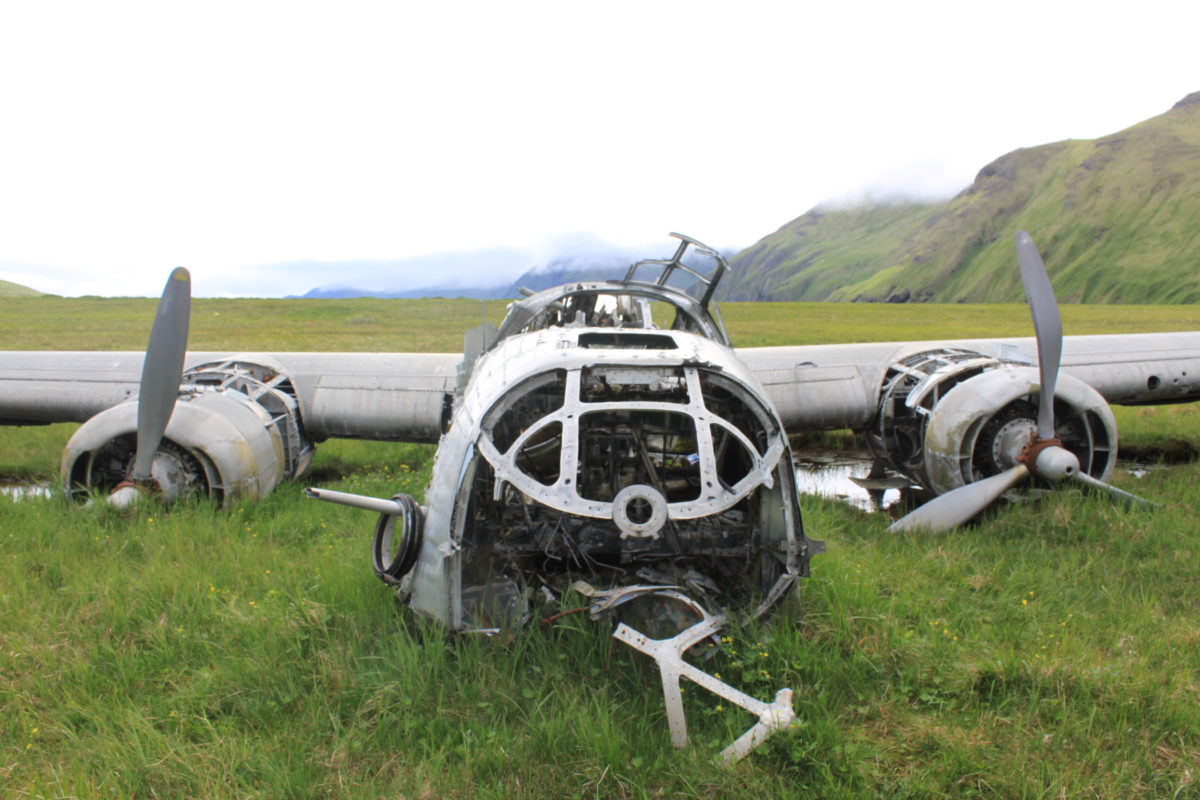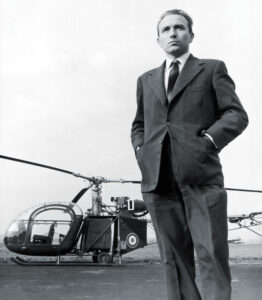Through binoculars I could see the wing section of Captain Jack Todd’s ill-fated Consolidated B-24D Liberator lying on a slope overlooking deserted Kiska Harbor. As we huffed our way up the verdant incline, bits of aircraft parts became more apparent in the grass the higher we ascended. A 1,200-hp Pratt & Whitney radial engine rested at the bottom of the hill where it had rolled. At the wing section we noted Japanese kanji characters scratched into the silver skin, still legible 67 years later. These etchings bore the signatures of the Japanese gunners who had brought down the B-24 in 1942, killing all onboard. More than scrap metal, the wing reflected the sacrifices of the green 21st Bombardment Squadron, fresh out of California and thrust into Alaska’s Aleutian campaign.
War wasn’t entirely hell for the newly formed 21st, it was downright tedious. Flying anti-submarine duty in Lockheed A-29 Hudsons and spread out among five different airfields along the West Coast from Muroc, Calif., to McChord Field in Washington, the squadron patrolled an endless scape of green roiling sea with little opportunity to engage an elusive enemy. Following the December 7, 1941, attack on Hawaii, Japanese submarines fanned out along the West Coast in an attempt to disrupt shipping and search for the American aircraft carrier fleet that had escaped the strike on Pearl Harbor. In the following weeks eight merchant vessels came under attack along the West Coast. Two ships were sunk and the Ellwood oil field near Santa Barbara, Calif., was shelled by a Japanese sub in February 1942.
Consecutive attacks by Japanese forces at Dutch Harbor, Alaska, on June 3 and 4, followed up by their seizure of Attu and Kiska islands at the western end of the Aleutian archipelago, compelled the United States to move squadrons north as reinforcements. Reassigned to the 28th Composite Group, Eleventh Air Force, and re-equipped with B-24D heavy bombers, the 21st was ordered north to help counter the Japanese threat. The 21st arrived at Cold Bay on the Alaska Peninsula on June 10 and was immediately ordered into the fray. The squadron departed Cold Bay the next day, refueling and arming up at Fort Glen on Umnak Island to fly the unescorted, 12- to 14-hour, 2,000-mile roundtrip to hit fog-shrouded Kiska. Leading the flight of six B-24s was Captain Jack Todd in Liberator serial no. 41-1088, flying his first mission as squadron leader.
Uninhabited Kiska had the finest deep-water harbor in the Aleutians, and the Japanese were quick to establish a presence there. Their foothold would eventually include a submarine base, anchorage for capital ships, 7,500-man garrison, electrical generating plants, infirmaries, bathhouses and even a bakery—all heavily defended with 75mm and 120mm anti-aircraft guns as well as an array of heavy machine guns and three- and six-inch naval guns.
Upon approaching the island, Todd’s crew cranked the bomb bay doors open in preparation for a run on the enemy vessels anchored in Kiska Harbor. But as they neared their target a burst of flak from the transport Awata Maru exploded in the Liberator’s bomb bay, destroying the aircraft and killing the 10-man crew. A Japanese film crew that accompanied the occupation force caught the attack on film and the clip was widely used in Nipponese news releases. Murderous flak dogged the remaining Liberators, which dropped their bombloads to little effect and headed back to Umnak.
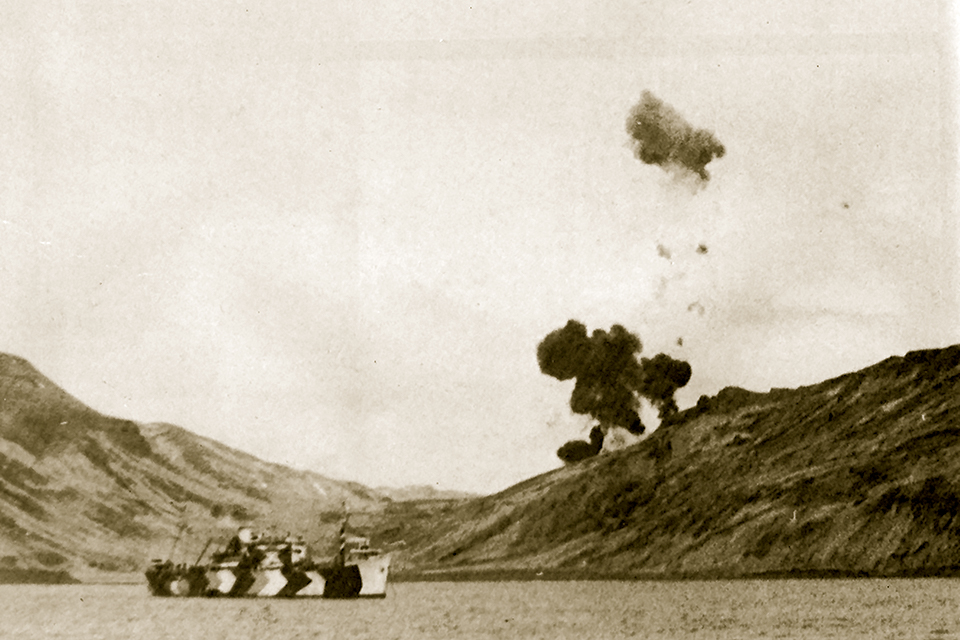
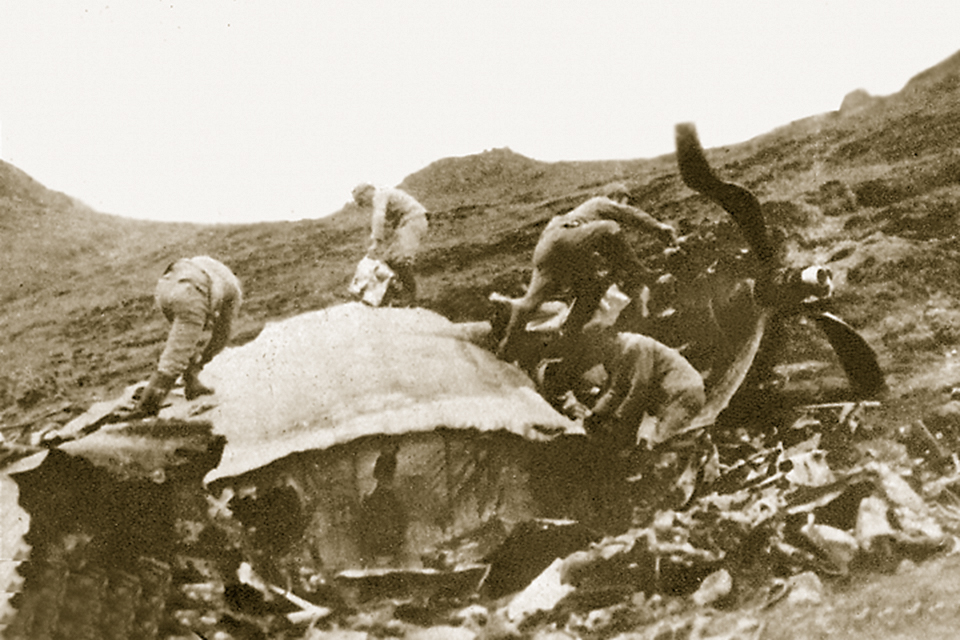
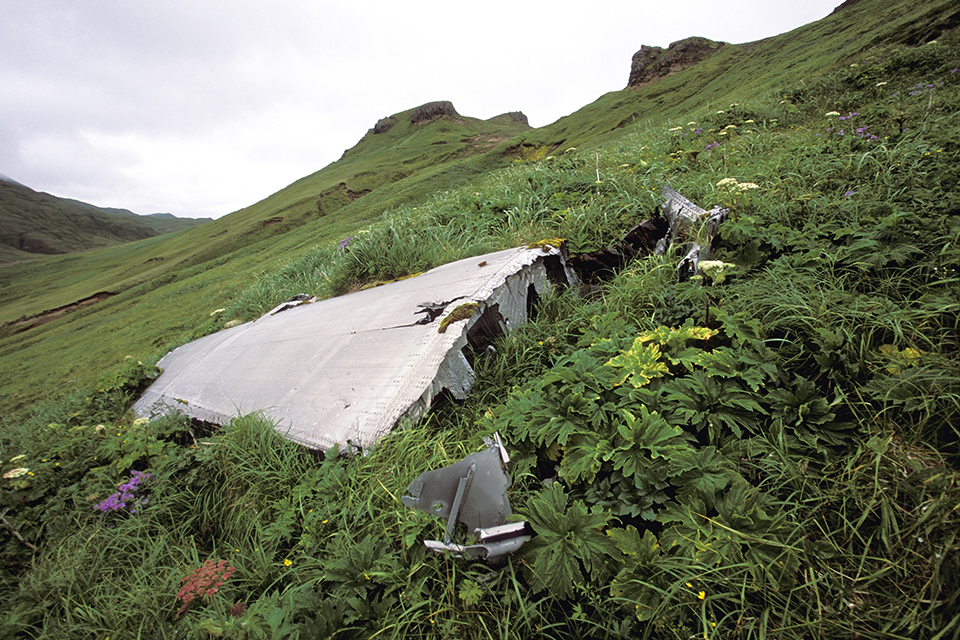
September saw the squadron move halfway down the Aleutians chain to the new airfield on Adak, shortening the distance to 220 nautical miles to Kiska and 390 to Attu. On September 14 the squadron took part in the first mission to Kiska with fighter escorts—Lockheed P-38 Lightnings and Bell P-39 Airacobras, which claimed five Nakajima A6M2-N Rufe floatplane fighters and a Kawanishi H6K Mavis flying boat. Two P-38s collided and were lost in the melee. The squadron hit Kiska Harbor again on the 25th, escorted by Eleventh Air Force P-39s and Curtiss P-40 Warhawks of the 343rd Fighter Group, plus a contingent of P-40s from No. 111 Squadron, Royal Canadian Air Force. The mission set shore facilities ablaze, downed two Rufes and damaged the Japanese submarine Ro-65.
Finally able to gain some footing, the 21st continued its attacks against Kiska with other Army Air Forces and Navy squadrons, subjecting the Japanese naval base at Kiska Harbor and the army base at Gertrude Cove to tremendous bombardments. Yunosuka Osawa, a Japanese news reporter assigned to cover Kiska, described an air attack on the island: “Sometimes they swoop down through cracks in the clouds dropping their bombs and hitting everything indiscriminately. I express my wonder at the fierceness of the enemy bombardment.”
It was no easier for the American aircrews. In addition to the threat from enemy fire, the notorious Aleutian weather was the bane of enemy and ally alike. In his account of the Aleutians and Kuril Islands campaigns, historian John Cloe described the mood before a mission in the American squadron ready room early in the campaign. “It would be a long mission,” he wrote. “Everything was against them: an alerted enemy, the long distance, the weather, no fighter protection and little chance of survival if forced down in the icy waters of the north Pacific.”
Reports of aircrews begging off missions due to heavy fog over Attu and Kiska were too common, so much so that the AAF sent Brig. Gen. William E. Lynd to investigate. With Lynd aboard, on December 9 B-24D no. 40-2367 took off from Adak, reconnoitered Kiska and then flew out to Attu and found favorable weather conditions. Ironically, on the return trip the crew arrived back at Adak to find it completely socked in.
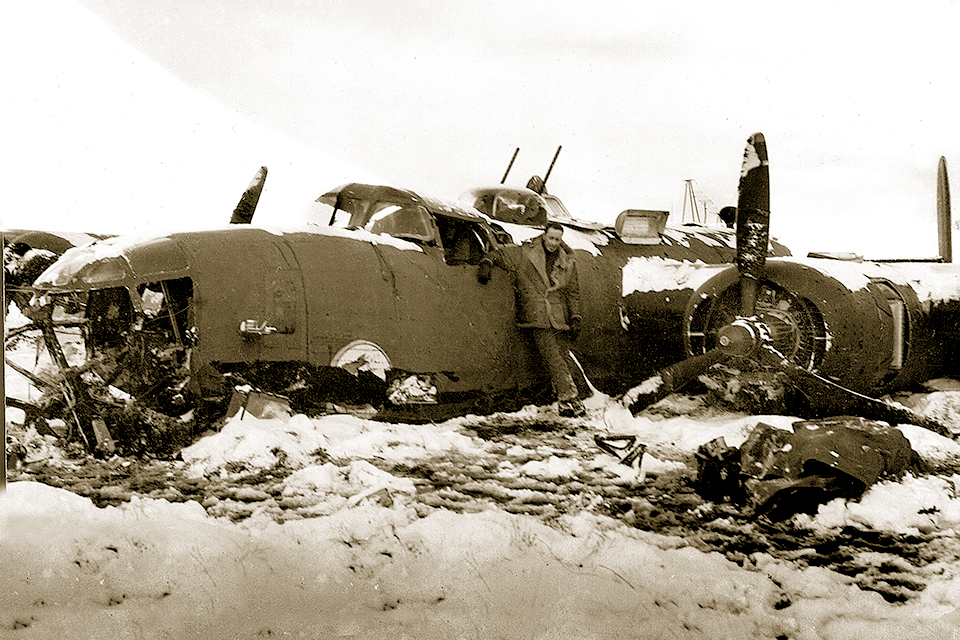
Pilot Captain John Andrews and copilot Captain Louis Blau circled Adak looking for a break in the weather. But, low on fuel, they decided to attempt a crash-landing on Atka, some 75 nautical miles east. Andrews skillfully put his “Libby” down at Bechevin Bay on Atka’s southwest shore. All walked away from the crash with minor injuries, the only casualty being Lynd, who suffered a broken collarbone. With its rear fuselage torn off, Liberator 40-2367 was a total loss, though a Navy crew later removed the machine guns.
Following the expulsion of the Japanese from Attu in May 1943, the 21st was able to step up attacks on Kiska that spring but lost two more Liberators to combat. The squadron participated in some of the first land-based attacks on the Japanese homeland, targeting the enemy bases at Paramushiru and Shimushu in the Kuril Islands. Japanese fighters intercepted a raid by the 21st and 404th Bomb squadrons, shooting down one B-24 from each formation.
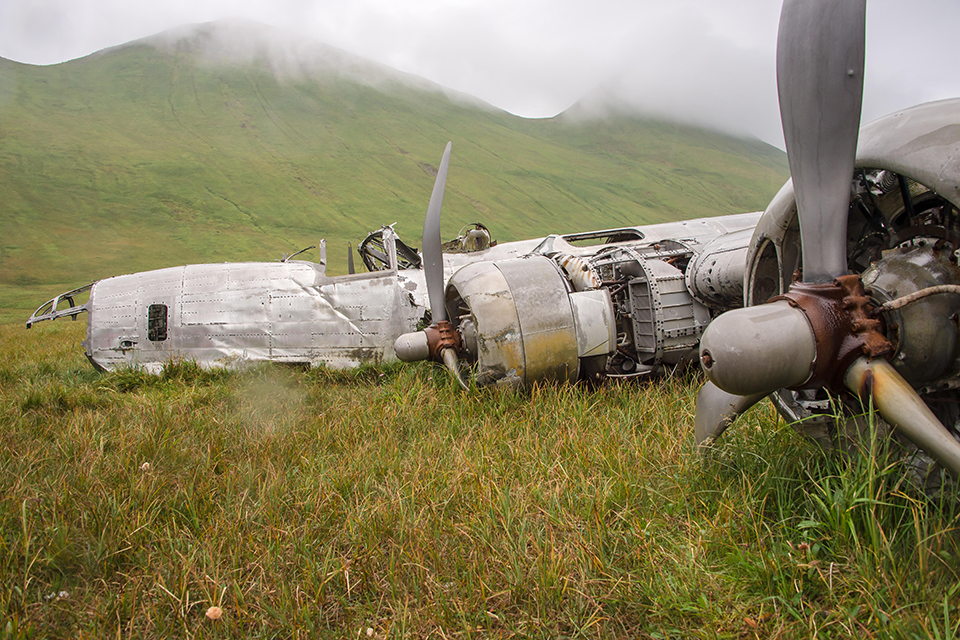
Visiting remote Atka some 72 years later, the Zodiac from our charter vessel Pukuk dropped us on the protected shore of Bechevin Bay and we trudged through sucking mud to the B-24 wreck site a quarter-mile inland. All was peaceful now, with a light breeze rustling the long-bladed beach rye grass that covers the island. Avian twitters had replaced the sounds of war as a hearty Pacific wren darted among the aircraft’s skeletal remains in search of food. The B-24 is being slowly consumed by the island as a native cow parsnip bush forces its way into the tail section, blocking any foray into the stern.
Fittingly, in 2008 President George W. Bush designated Liberator 40-2367 a World War II Valor in the Pacific National Monument. Today it is part of the Aleutian Islands World War II National Monument, serving as a memorial to
the bravery and sacrifice of B-24 crews in the far-flung Aleutian and Kuril campaigns.
In 2009 Brendan Coyle spent 51 days on uninhabited Kiska photographing relics of the Japanese invasion, and he returned to the Aleutians in 2015 to capture images of Attu, Kiska, Great Sitkin, Adak and Atka. Coyle is the author of War On Our Doorstep: The Unknown Campaign on North America’s West Coast and Kiska: The Japanese Occupation of an Alaska Island, which are recommended for further reading, along with The Aleutian Warriors: A History of the 11th Air Force & Fleet Air Wing 4, by John Haile Cloe.
This feature originally appeared in the July 2020 issue of Aviation History. To subscribe click here!

